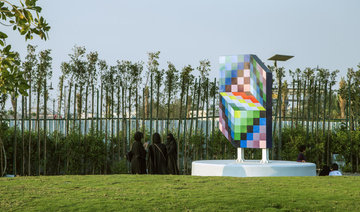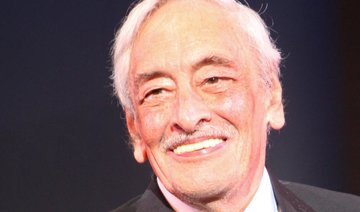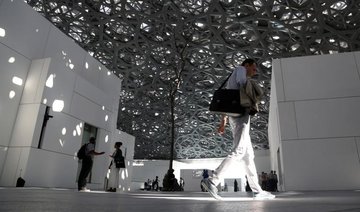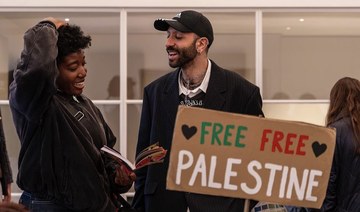DUBAI: Art lovers, curators, collectors and enthusiasts are rejoicing as the biggest and most globally diverse art fair is set to open from March 21 to 24 at Madinat Jumeirah. Under the patronage of Sheikh Mohammed bin Rashid Al-Maktoum, Art Dubai’s lineup this year will feature a record 104 galleries from 47 countries. Art lovers can enjoy unique and new contemporary artists and a significant contingent of returning galleries.
Founded in 2007, it’s become one of the leading international fairs in the arts calendar and features a great range of galleries in one setting. Imagine a compiled list of the most prominent art galleries from Buenos Aires, Argentina to Kolkata, India to Turin, Italy and more, all in one fair over three days. This year will feature new first-time participants from Iceland, Ethiopia and Kazakhstan alongside the returning 77 galleries.
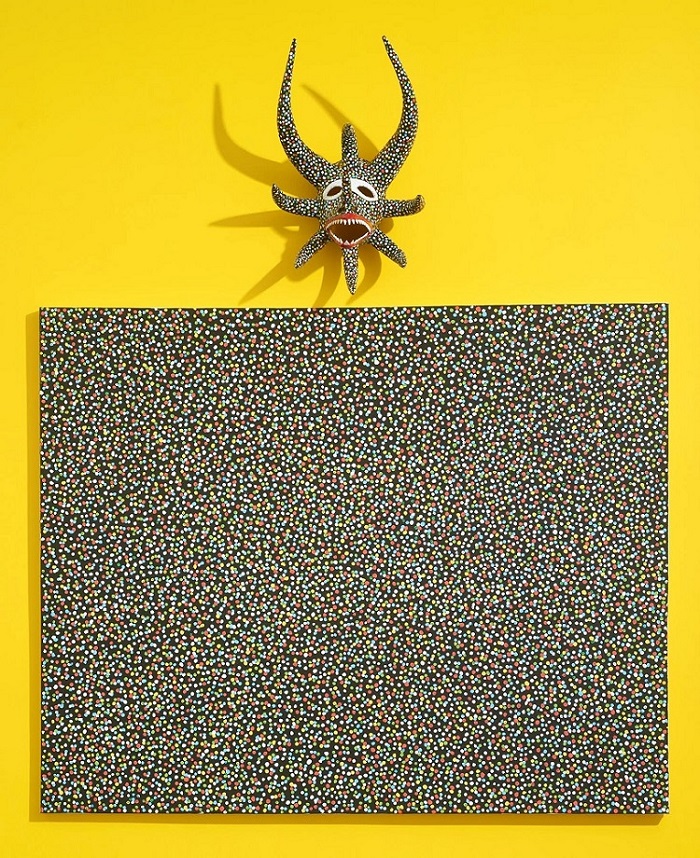
Jesús Bubu Negrón, Ethnographic Abstractions (2016) in the Contemporary Hall. (Photo courtesy: Henrique Faria)tion
“For our 2018 edition, we will be launching Residents, a pioneering and unique platform that brings together different energies, synergies, geographies and artistic practices which aren’t usually seen together in one place,” said Pablo del Val, Art Dubai’s artistic director.
Art Dubai’s halls are divided into three main halls, Contemporary, Modern and, for the first time, Residents.
Art Dubai’s Contemporary’s diversity is signified by its strong representation from the Middle East, North Africa and South Asia. Galleries include Selma Feriani Gallery (Tunis, London), Gypsum Gallery (Cairo), Artwin Gallery (Moscow), Artside Gallery (Seoul), Gallery One (Ramallah), the Athr Gallery Jeddah, Saudi Arabia and Gallery 57 from Accra, Ghana, among others.
The artists range from household names to new, up-and-coming artists with a wide range of artistic media: painting, drawing, installations, photography and more.
Art Dubai’s Modern will feature a record-breaking 16 galleries exhibiting artists from 14 countries. Participating galleries will present renowned Modernists from the Middle East such as Gebran Tarazi, Abdel Hadi El-Gazzar, Hamed Abdalla and others. Leading Modernists from South Asia include Zahoor ul Akhlaq, Anwar Jalal Shemza and M.F. Husain, while notable African Modernists will include Mohammed Naghi, Reinata Sadimba, Ernesto Shikhani and more.
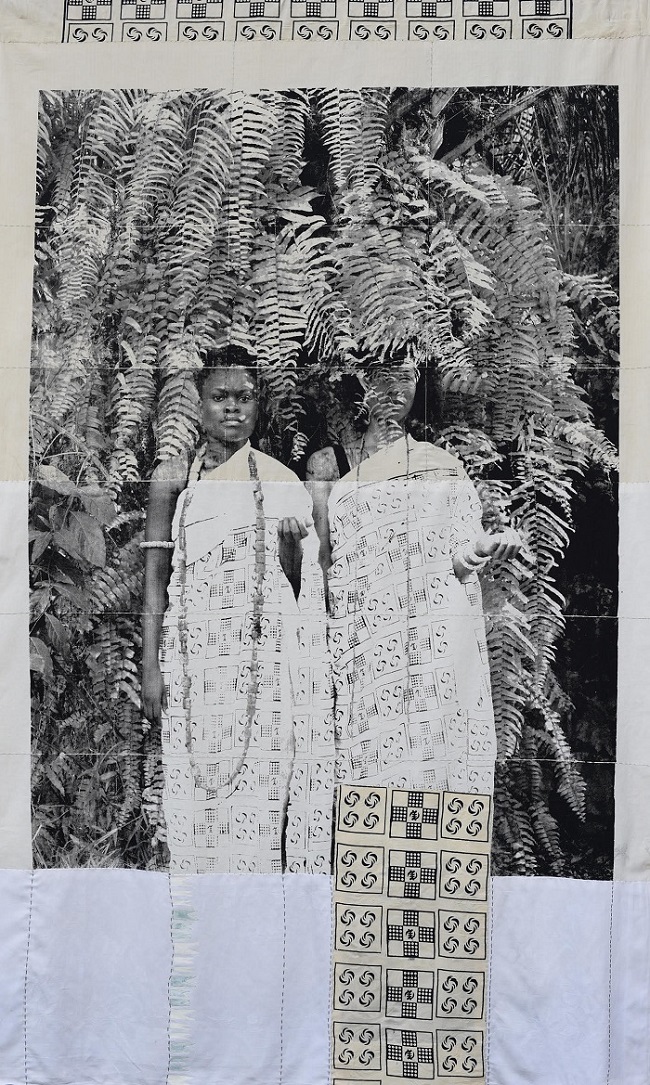
Zohra Opoku, Debie, (2017) in the Residents Hall. (Photo courtesy: Zohra Opoku and Mariane Ibrahim Gallery)Caption
Art Dubai’s Director Myrna Ayad said: “It’s very exciting for us to witness the growing appreciation of modern masters from the region and we are pleased to be the only platform in the world to showcase these museum-quality pieces in our largest ever Modern section, which has been the most oversubscribed to date. Serving as an educational platform and theoretical framework for the works on show, Art Dubai Modern will be accompanied by our second annual Modern Symposium at the fair this year.”
For its 12th edition, Art Dubai is presenting a gallery to showcase its 11 solo gallery presentations by artists who took part in their residency program. The program’s aims are to support artists by giving them a platform to develop their practice and create new bodies of work, inspired and influenced by their stay in the UAE. Their work will be presented by the artists’ respected galleries in a special exhibition accompanied by a range of public events and open studios hosted by the residency spaces.
Art Dubai aims to create a dialogue, engage socially in matters of art and, more importantly, educate on the significance of art in our everyday lives. Dubai is an international melting-pot and a capital for art creators, curators and directors from all over the world to meet and present their finest to the public, all in one place.
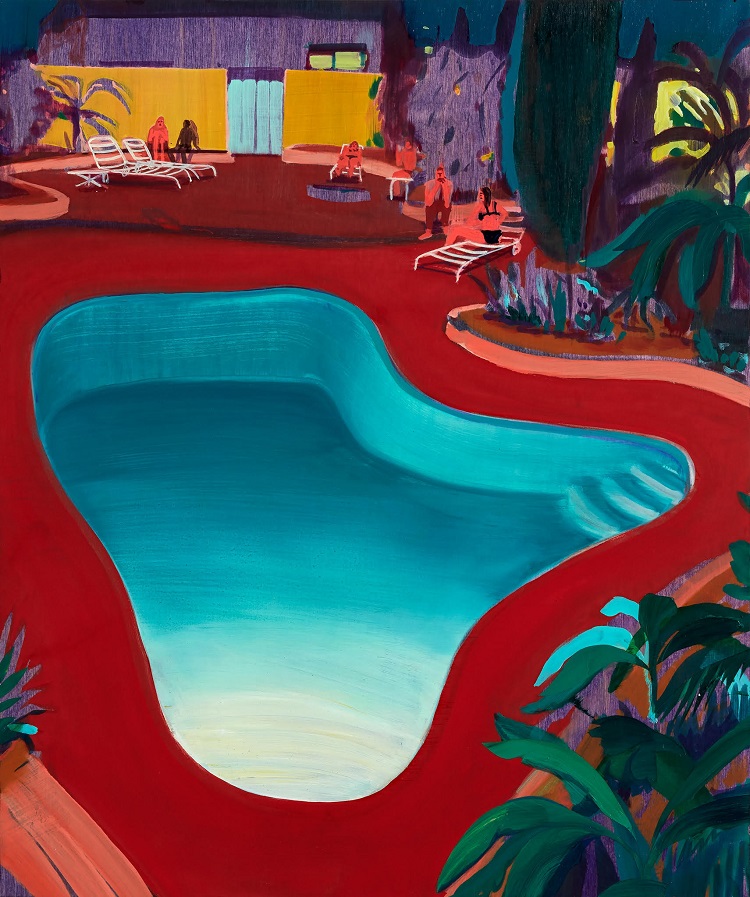
Jules de Balincourt, Valley Pool Party (2016) in the Contemporary Hall. (Photo courtesy: The artist and Victoria Miro Gallery)Caption
Art Dubai 2018: Big diary date for art curators, collectors and enthusiasts
Art Dubai 2018: Big diary date for art curators, collectors and enthusiasts
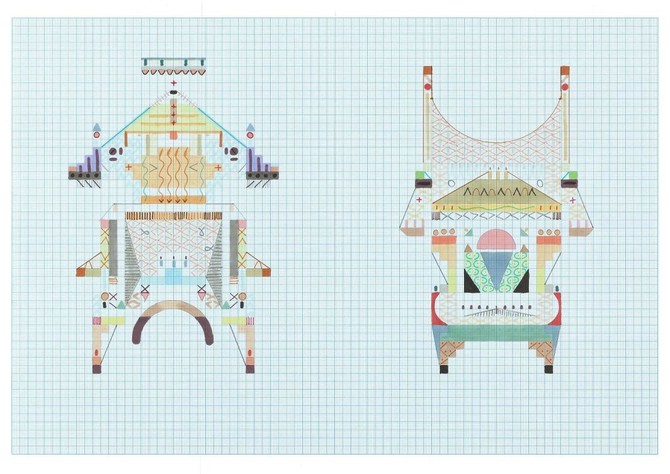
‘Material Woman’ exhibition in London creates synergy of Arab women’s fashion and art

- Curation tells a “story about how women use their hands to craft their destinies,” Shoucair says
LONDON: The worlds of fashion and art from Arab female creatives converged this week at the “Material Woman” exhibition in London.
The exhibition, held from May 17 to May 19 at Soho Revue, is the brainchild of the art collective Hayaty Diaries, in collaboration with the fashion platform and pop-up series 3eib.

Featuring an eclectic mix of sculptural art, mixed media, projection installations, fashion and jewelry, the exhibition explored craftsmanship and materiality.
“Each element came together to tell a cohesive and beautiful story about how women use their hands to craft their destinies and honor their heritages through both creative worlds of art and fashion,” Lebanese curator and Hayaty Diaries co-founder, Christina Shoucair, told Arab News.
The curatorial process began with the pairing of artists and designers, creating a harmony between the works.

Bahraini artist Zayn Qahtani’s shrine-like objects, featuring delicate ethereal drawings on date paper, explore themes of venerative mourning. These are paired alongside a series of rustic sculptures and draped garments by Egyptian designer Nadine Mos.
Lebanese artist Yasmina Hilal’s photo sculptures, which incorporate her distinctivve metalwork and soldering technique, are complemented by a curated display of contemporary silver and gold accessories by Celine Dagher, a Lebanese jewelry designer.
Meanwhile, Egyptian artist Hanya Elghamry examines the process of remembering by graphically recreating various details and narratives in her installation “Abandoned Projection.” Set as a backdrop against her floating “Tampered Redux” series, along with Moroccan designer Hanan Sharifa’s mesh and delicate dresses, the space offers visitors an immersive experience.
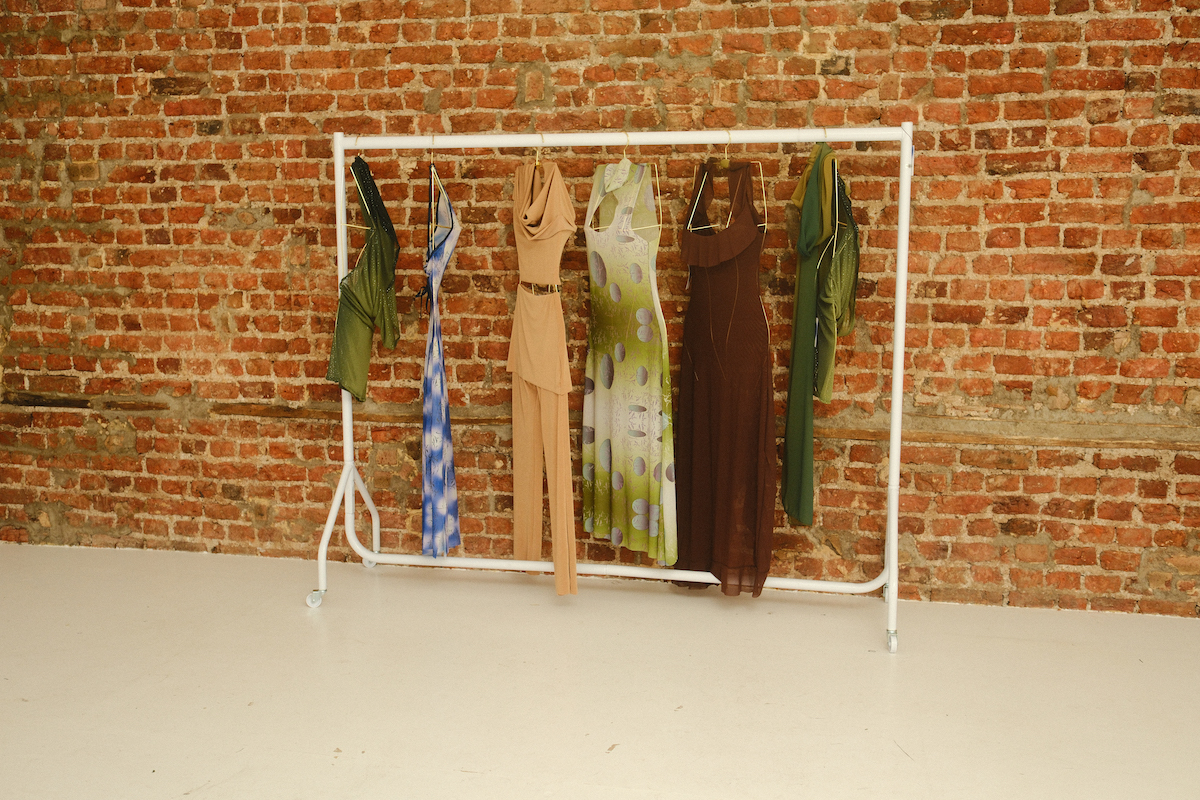
“Christina and Kinzy presented the vision for The Material Woman and I loved the idea of blending the worlds of fashion and art together and utilizing the theme of materiality as a vehicle of creative empowerment and liberation,” 3eib founder, Dania Arafeh, told Arab News.
Hayaty Diaries, which focuses on celebrating the artwork of Arab women, marked its debut last December with its inaugural exhibition, “Through Their Eyes: Perspectives Unveiled,” in the British capital.
“Our Hayaty Diaries journey has been incredible. We’ve had the privilege of meeting many creatives from the region and have felt the warmth and support of the community. We are immensely grateful for all the encouragement we have received along the way,” Egyptian-Saudi curator and Hayaty Diaries cofounder Kinzy Diab told Arab News.
The London-based collective is now preparing for its exhibition “Levitate,” which will run from June 6 to June 16 and center around themes of fantasy and imagination.
Hoor Al-Qasimi appointed artistic director of the Biennale of Sydney

DUBAI: The Biennale of Sydney announced this week that Emirati creative Hoor Al-Qasimi will become its artistic director for 2026.
The 25th edition of the biennale will run from March 7 to June 8.
Since its inception in 1973, the biennale has grown to become one of the longest-running exhibitions of its kind and was the first biennale established in the Asia-Pacific region.
Al-Qasimi created the Sharjah Art Foundation in 2009 and is currently its president and director. Throughout her career, she acquired extensive experience in curating international biennials, including the second Lahore Biennale in 2020 and the UAE Pavilion at the 56th Venice Biennale in 2015.
In 2003, she co-curated the sixth edition of Sharjah Biennial and has remained the director of the event since.
Al-Qasimi has been president of the International Biennial Association since 2017 and is also president of the Africa Institute. She has previously served as a board member for MoMA PS1 in New York and the UCCA Center for Contemporary Art in Beijing, among other roles.
She is also the artistic director of the sixth Aichi Triennale, scheduled to take place in Japan in 2025.
Saudi pop star Mishaal Tamer feels ‘honored and grateful’ ahead of sold-out London gig

- Singer tells Arab News his fans in the city have a special place in his heart but he owes his success to people all over the world who have embraced his music
- He says his debut album, “Home is Changing,” out in October, is a tribute to the changes and reforms that have swept through the Kingdom in recent years
LONDON: Saudi singer Mishaal Tamer said he feels honored to be performing his first headline show outside Saudi Arabia in London and is grateful to his fans there for their support.
Speaking to Arab News ahead of his sold-out gig on Friday at Camden Assembly, a live music venue and nightclub in Chalk Farm, Tamer said his fans in London will always have a special place in his heart.
“The people attending the show in London have been with me from before the starting line and I really appreciate that,” he said of the 220 people who will attend the event. “I will love those people forever and they will be in my heart forever.”
Tamer also thanked his fans in Saudi Arabia and elsewhere in the world, saying he owes his success as an independent artist to them.
“The kids that are back home and the ones abroad that have found me have been supporting me,” he said. “This would be impossible without them. I am grateful to the fans for listening to the music and sharing it.
He told how he was approached by two fans in a restaurant after arriving in the UK, which helped him realize how his profile was growing.
“One of them was Saudi, the other wasn’t,” Tamer said. “When I looked at that, it made me realize that not only was this bigger than I expected for me, as an artist, but that what we’re doing is bigger than me.”
His debut album, “Home is Changing,” is due for release in October and he said it is a tribute to the changes and reforms that swept through the Kingdom in recent years.
“There are so many opportunities that keep popping up, so many cool new things,” he added. “People have the freedom and creativity to make the world around them and the environment around them, to shape it into what they see in their heads.
“It feels almost like every other country is decaying whereas the Kingdom is growing and that feeling makes me proud.”
The evolution of Saudi Arabia “sets an example of always being hopeful for the future and having a positive attitude,” Tamer said. “And I think the optimism that we have right now in the Kingdom is a beautiful thing.”
Saudi filmmaker Abdulrahman Sandokji’s ‘Underground’ discusses the Kingdom’s music scene

- ‘Unfolding the unseen is my thing,’ says Abdulrahman Sandokji
DUBAI: “In film school, they tell you that your first film should be a documentary — train in a simpler form, then go to fiction,” says Saudi filmmaker Abdulrahman Sandokji. “So, naturally, I started with documentaries. But I got hooked.”
Over 15 years later, Sandokji still hasn’t moved on to fiction. Not that that’s an issue for him. His documentaries — produced by the company he founded, Basar Media — have proven immensely satisfying.
“A fiction film can take one or two years to shoot. I have no patience with waiting days and days to shoot one scene. I want things faster and more surprising,” he tells Arab News.

“And (documentaries) are honest. You’re talking about real stories. Unfolding the unseen is my thing, you know? I want to go into these deep places and show them to people,” he continues. “It’s a way to understand people, to really see people. To pick a flower from lots of beautiful gardens and plant them in your own garden. It’s more of a journey of discovery for me, you know? That’s what I love about documentaries.”
Sandokji’s breakthrough came with his 2014 film “Phosphine,” which he describes as a “Michael-Moore style” investigative documentary. It explored how the titular chemical — a potentially deadly respiratory poison — had been used (out of ignorance rather than malice) in homes to kill cockroaches, rats and other pests. While the actual occupants had been told to leave their apartments for five or six days, their neighbors were not, and the odorless gas killed them.
Sandokji put his documentary up on YouTube. It got 5 million views in five days, he says, adding that, at the time, he and his colleagues were delighted if they got 100,000 views on any of their videos, because they “weren’t funny — they weren’t comedies.” But “Phosphine” ended up making a difference to society, as well as to Sandokji’s career.
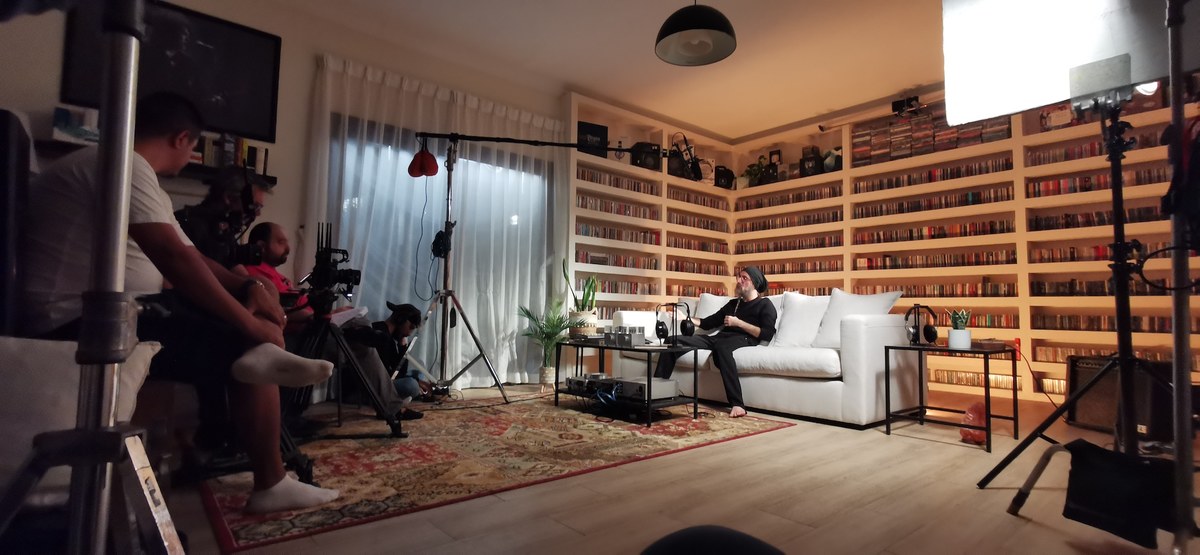
“We were on TV shows and talk shows — we were overwhelmed. Lots of social movement happened and governmental sectors held very urgent meetings about this substance. The Ministry of Health set up a hotline about it,” he says. “That was when I thought, ‘OK. Maybe this is your thing. Being a voice for those who want their voices to be heard.’”
Unlike “Phosphine,” Sandokji’s latest doc, “Underground,” is not a “tragic story.” But, once again, it was a “journey of discovery” for him — one that delves into the Kingdom’s burgeoning alternative music scene.
The idea — as for many of his films — was not Sandokji’s own. “When I analyze myself, I’m more of a person who receives an idea and then gets to enlarge it,” he says. “When I generate an idea myself, people go, ‘Mmm. No.’” He laughs. “They’ll go, ‘How about this idea instead?’ I’m like the gas — just throw the spark on me and I’ll explode, you know?”
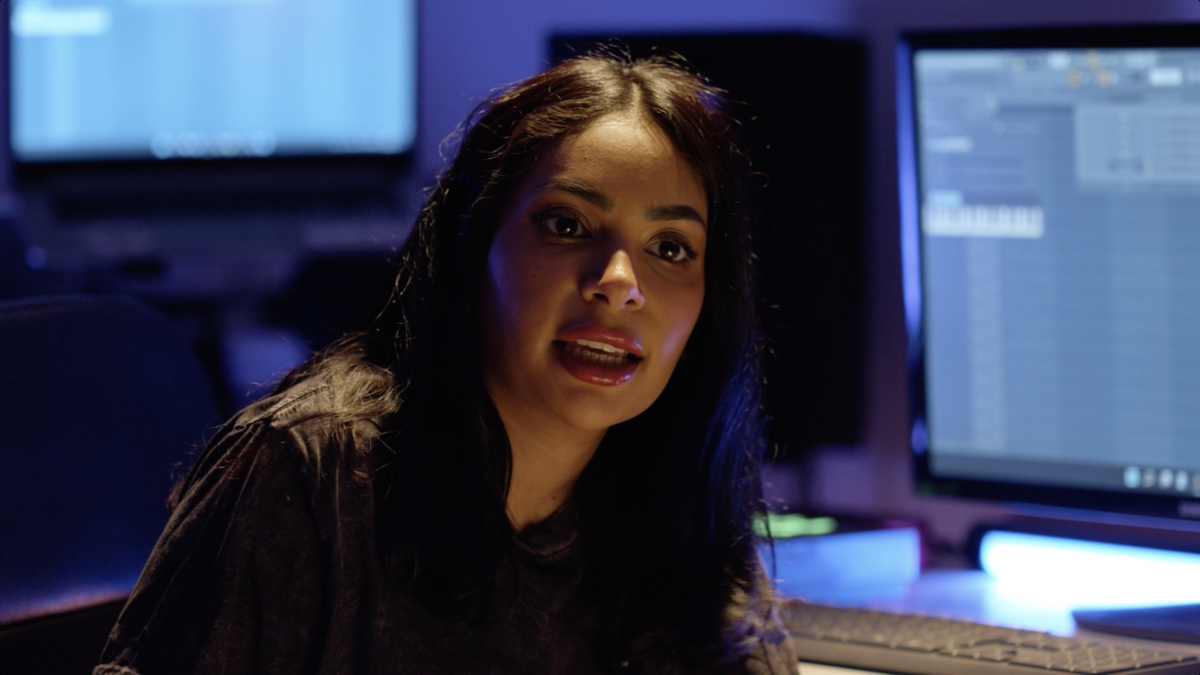
The “spark” for “Underground” came from a friend, Tamer Farhan. “He’s passionate about underground music. He knows all these artists,” Sandokji says. “And he opened the window to me and said ‘Come and have a look.’”
What Sandokji found was a wealth of talent and experience that has largely gone unnoticed in Saudi Arabia — understandably, given that until recently live music was largely outlawed in the Kingdom, and music that wasn’t commercial Khaleeji pop or classical Arabic fare was frowned upon.
“These people are good people,” says Sandokji. “Over the years people talked about the music underground as this place with drugs and all this prohibited stuff. But no. They are nice. They have feelings. They love their music and they’re passionate and they’re kind.”
That passion shines through in “Underground,” whether from veterans such as metal band Wasted Land’s frontman Emad Mujallid or relative newcomers such as DJ Cosmicat (Nouf Sufyani) and Salma Murad. All the artists involved are given the opportunity to discuss their craft and love for music in depth, and to play some of their music live.
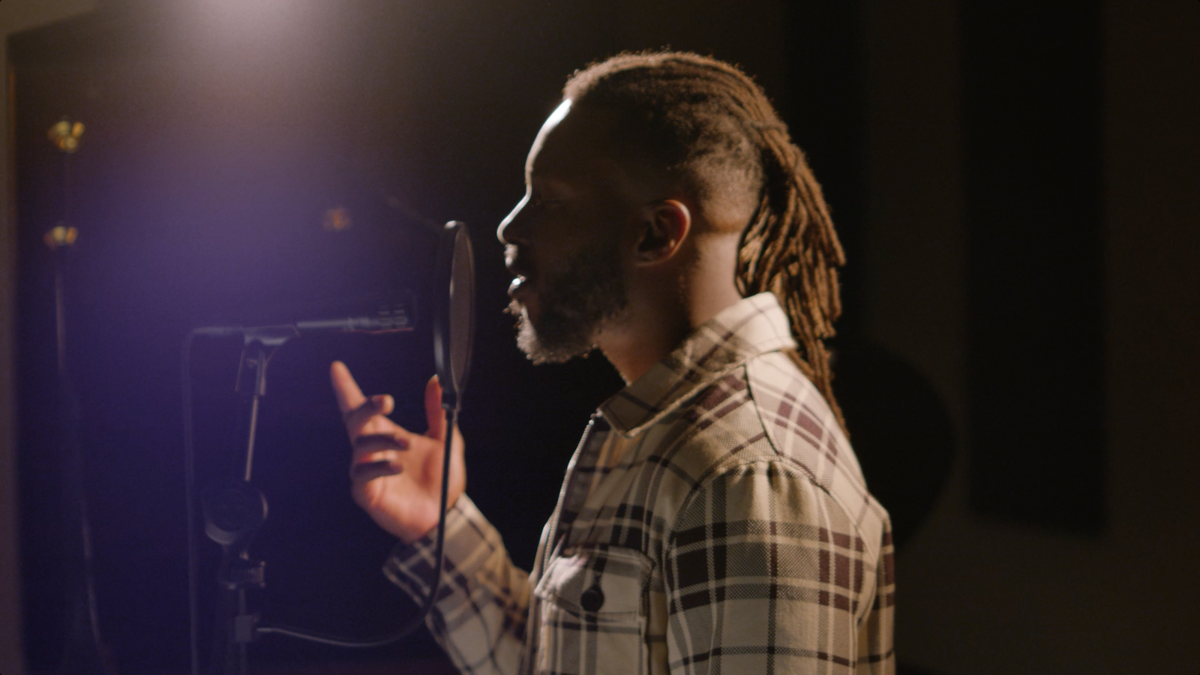
“(The songs) are not recorded and synced,” Sandokji says. “I wanted to show the audience how talented they are.”
So far, that audience is whoever attended the premiere on the opening night of the Saudi Film Festival on May 2 — another landmark for Sandokji, he explains. “Usually they choose fiction films — good fiction films — for the opening. I was always watching them thinking ‘When am I going to make a movie that could be screened in the opening? I’m a documentary maker, nobody would give me that chance.’ But it happened.”
And he believes “Underground” has the potential to grab international attention. It’s already been submitted for consideration at several large festivals, but the main aim since he started shooting it in 2022, Sandokji happily admits, has been to get the film on Netflix. There are also discussions underway about turning it into a TV series.
“It’s something people will want to know more about, I think,” he says, before citing the words the movie concludes with, when Murad is discussing what music means to her: “It’s powerful. It’s beautiful.”
“When Salma said that, I had goosebumps,” Sandokji says. “I thought, ‘Yes! These are the words the movie has to end with.’ Music is powerful; it can make you very strong, it can make you very weak… it’s magical.”
El Seed launches Tunisian olive oil brand Tacapae with artworks for bottles

DUBAI: French-Tunisian artist El Seed’s take on Arabic calligraphy (sometimes referred to as ‘calligraffiti’) has embellished favelas in Brazil, marginalized buildings in Cairo, and the Saudi desert. He is known for working with local communities to share messages of human connection, based on quotes from influential writers and philosophers.
In a departure from his usual large-scale artworks, the artist recently launched his most intimate endeavor to date. The project is called “Tacapae” and consists of olive oil-filled bottles decorated with El Seed’s swirling calligraphy. The name of the brand is inspired by the ancient Greek name of the artist’s hometown, Gabes, in southern Tunisia, from where the olive oil is sourced.

“I didn’t want to call it ‘El Seed Olive Oil’ because I don’t link the oil to myself,” El Seed tells Arab News at his Dubai studio in Alserkal Avenue. “I’m the founder, but the goal is to have a bottle designed by other artists every year. It’s a kind of partnership.”
El Seed explains that his cousin informed him of a plot of land for sale in Gabes. “And it happened that the olive trees of this land were planted by my great-grandfather,” he says.
El Seed purchased the land and its trees now provide the oil for Tacapae. A total of 31 bottles (a tribute to the land’s original 31 trees) were personally hand-finished by the artist himself.

The most powerful aspect of the ceramic, handmade bottles is the quote El Seed used. Translated into Arabic from a quote by 20th-century US novelist John Dos Passos, it reads: “You can snatch a man from his country but not the country from a man’s heart.”
Those words have resonated with El Seed his whole life. “Nobody can take away from you all the memories that you carry for a particular place,” he says. “I grew up in France, I live in the US and Canada and I spend some time in the Middle East, but my main focus is in Tunisia. I carry it with me.”


